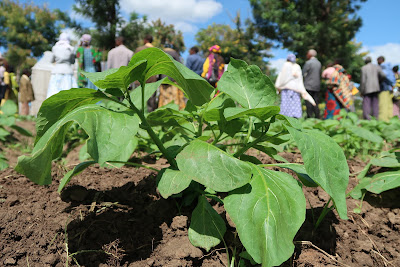MEDICINAL VALUES OF BLACK NIGHTSHADE
What is black nightshade?
Black
nightshades (Solanum nigrum ) is
worldwide weeds - consumed as vegetable
- of arable land, gardens, rubbish tips,
soils rich in nitrogen, in moderately light and warm environment. They are,
however, also widely used as leafy herbs and vegetables, as a source of fruit
and for various medicinal purposes. Therefore, human consumption of their
leaves and fruits as food is widespread, particularly in Africa.
Its
medicinal importance
Various
parts of many of the species belonging to the section Solanum are widely used medicinally throughout the world. Their use
as such is recorded from the earliest times and various species, especially Solanum nigrum, are mentioned and often
illustrated in all of the early Herbals, with Dioscorides being one of the
first to record their medicinal properties. Since then this ‘species’ has
continued to be widely acclaimed for its medicinal effects in every country in
which the taxon is found.
- · For example, “Nightshade is used for those infirmities that need cooling and binding” and that it was “good against ‘St. Anthonies fire’, the shingles, panic of the head, heart burning or heat of the stomach.
- · In North America, the Houmas Indians use an infusion made from boiled roots of this ‘species’ to administer to babies with worms, and crushed green leaves mixed with a grease to make poultices for sores, while the Rappahannocks used a weak infusion to cure insomnia.
- · In East Africa the raw fruit is chewed and swallowed for treatment of stomach ulcers or for general abdominal upsets which lead to continued stomach-ache. Infusions of leaves and seeds are rubbed onto the gums of children who have developed crooked teeth.
- · Pounded leaves are soaked in water, fermented and used for the treatment of boils, ulcers and swollen glands.
- · Unripe berries are used to treat ring worms. Various parts of the plant are also believed to cure malaria, black fever, dysentery and urinary infection (Kokwaro 1976).
- The Zulus use an infusion as an enema for abdominal upsets in children; the southern Sotho rub burnt and powdered root in to scarifications on the back for the relief of lumbago; a paste made from unripe berries is used among African tribes as an application for ringworm; the Xhosa also use the plant for disinfecting anthrax-infected meat.
- · In Zimbabwe the plant is used as a remedy for malaria, blackwater fever and dysenteries, while the juice or decoctions of the herb were formerly made into an ointment for foul ulcers (Watt and Breyer-Brandwijk 1962).
- In Kenya unripe fruits are applied to aching teeth and squeezed onto babies’ gums to ease pain during teething. Leaves and fruits are pounded and the infusion used against tonsillitis. Roots are boiled in milk and given to children as a tonic (Maundu et al., unpublished). Indigenous information reported by Opole et al. (unpublished) indicates that leaves boiled with milk are used to relieve sudden stomach ache, boost the health of expectant mothers and/or relax the uterus of both pregnant and lactating mothers. The same mixture prevents muscular pains among old people or those suffering painful joints, especially those associated with arthritis or with malarial fever.
- Raw roots of S. nigrum were also found to be eaten for stomach-ache in Tanzania, where ground and soaked leaves of S. villosum were reportedly placed on swellings and fruit juice squeezed into sore eyes. The report of a case of conjunctivitis in Tanzania which had failed to respond to conventional treatment administered over a week is particularly interesting; the pain was instantly relieved and all inflammation disappeared within 4 days when treated with a leaf juice extract from S. americanum.
Despite
its medicinal values, solanum nigrum is
typically consumed as vegetable recipe. It constitute highly level of nutrient.
Several studies have been conducted to investigate the nutritive value of the
‘vegetable black nightshades’. From this it is evident that these species
constitute nutritious vegetables.
The
leaves can provide appreciable amounts of protein and amino acids, minerals
including calcium, iron and phosphorus, vitamins A and C, fat and fibre, as
well as appreciable amounts of methionine, an amino acid scarce in other
vegetables (Fortuin and Omta 1980; FAO 1988).
Moreover
the berries can apparently yield high mounts of iron, calcium and vitamin B
(Fortuin and Omta 1980), and appreciable amounts of vitamin C and carotene
(Watt and Breyer-Brandwijk 1962). The seeds too contain vitamin C and carotene
(Watt and Breyer-Brandwijk 1962). The nutrient values may, however, vary with
soil fertility, plantage and type (i.e. variant or species) (Chweya 1997).
Imbamba (1973), for example, found that the leaf protein content of ‘S. nigrum’
was dependent on the age of the plant.
Moreover,
the application of nitrogen increases the amount of ascorbic acid and protein
while decreasing the calcium content in the leaves (Chweya 1997). The values of
available ascorbic acid depend on the method of cooking. Mathooko and Imungi
(1994) observed that ascorbic acid content decreased with both an increase in
the cooking time and in the volume of water used for cooking. This loss could
reach as much as 75-89% when boiling the vegetable for as long as 20 minutes.
However,
leaves boiled with six volumes of water for 15 minutes resulted in the loss of
approximately 70% of ascorbic acid. Similar reductions in the levels of
vitamins A and C through excessive boiling have been reported for various other
local vegetable plants.





No comments:
Post a Comment